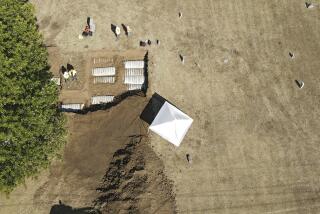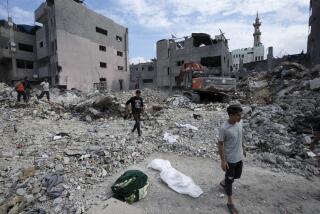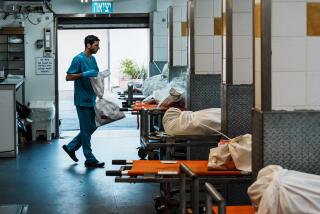OKLAHOMA CITY: AFTER THE BOMB : Families Cling to a Fragile Hope
OKLAHOMA CITY — As a cold, windblown rain hit the bombed-out Alfred P. Murrah Federal Building on Wednesday, family members of those still missing in the rubble continued to cling to hope--but of a much reduced kind.
Psychologists working with the families huddled at the First Christian Church said that much of the talk has shifted in the last two days. No longer are families discussing the possibility that searchers might miraculously find someone alive in the rubble.
“Now they’re just hoping for a body,” said psychologist Karen Sitterie, who came from Dallas to be part of the Red Cross effort in assisting the families of the dead and the missing. “Everybody wants at least a body to bury.”
And a man who endured a 10-day wait before his mother’s body was recovered is worried that people whose loved ones are never retrieved may be forced to suffer like the families of Vietnam War soldiers listed as missing in action.
“People mostly are hoping for closure,” said John Long, a San Antonio computer salesman whose mother, Rheta, was a secretary for the Agriculture Department. “I just pray that they get the same opportunity for solace I got when I got to say goodby to my mother.”
By day’s end, the toll of bodies recovered had increased to 144, with 33 still missing. Gov. Frank Keating earlier had estimated that as many as 20 bodies may never be recovered, although officials closer to the search dismissed that as a guess.
At the bomb site, fire officials said that with the help of large equipment, all of the rubble may have been extracted and searched by today. The head of the state insurance commission has promised to seek a change in a state regulation that mandates a seven-year waiting period before the survivors of a missing person can receive life insurance benefits.
The recovery Wednesday of the bodies of an elderly couple and a child was emotionally difficult for searchers, Assistant Fire Chief Jon Hansen said.
“That kind of represents what we’ve been dealing with,” Hansen said. “It’s affected people of all ages. . . . It’s pretty tough in there right now.”
One psychologist was concerned that, despite outward appearances that the victims’ families are coping, they may suffer long-term trauma unless they vent their anger.
“There is a lot of anger (among the families) that needs to be dealt with, more than I’ve even seen in a disaster,” said Daniel C. Broida, a psychologist from Rochester, N.Y., who has helped in several disaster efforts, including the Northridge earthquake. “This is a disaster that didn’t have to happen, and people must come to terms with that or there is a possibility of long-term post-traumatic stress.”
Since just hours after the bombing, the First Christian Church--located in a peaceful neighborhood a mile from the bombing site--has been the headquarters for the family assistance effort by the Red Cross, Salvation Army and other agencies.
Trees along the walkway to the church are tied with ribbons that have come to symbolize the tragedy and the recovery effort: blue for the victims, yellow for the missing and purple for the confirmed dead.
“This is a sad place, but it is a different kind of sadness,” said Tamra Varga, a mental health coordinator in the Red Cross effort. “(But) people aren’t all crying and moping, and it’s much better for them to be here than at home staring at a wall.”
More to Read
Sign up for Essential California
The most important California stories and recommendations in your inbox every morning.
You may occasionally receive promotional content from the Los Angeles Times.










